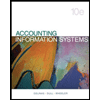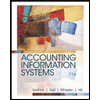
Accounting Information Systems
11th Edition
ISBN: 9780357156032
Author: Ulric J. Gelinas; Richard B. Dull; Patrick Wheeler
Publisher: Cengage Limited
expand_more
expand_more
format_list_bulleted
Textbook Question
Chapter 9, Problem 1SP
The following is a list of six control plans from this chapter, and these are followed by a list of five definitions or descriptions of control plans. Match the five definitions or descriptions with a control plan that best matches the definition. Because there are six control plans, you should have one letter left over.
Control Plans
- A. Limit checks
- B. Tickler files
- C. Public key cryptography
- D. Compare input data with master data
- E. One-for-one checking
- F. Manual reconciliation of batch totals (hash totals)
Definitions or Descriptions
- 1. Determines if a customer number has been input correctly.
- 2. Ensures that transmitted messages can be read only by authorized receivers.
- 3. A control plan that confirms a value that was entered is within a valid range.
- 4. An area (electronic or manual) where documents or other items are stored that need follow-up.
- 5. Used to detect changes in batches of events to ensure the validity, completeness, and accuracy of the batch.
Expert Solution & Answer
Trending nowThis is a popular solution!

Students have asked these similar questions
Do not answer wit incorrect values i will unhelpful!
What are the implications of missing a credit card payment in finance?
Omni Advisors, an international pension fund manager, uses the concepts of purchasing power parity (PPP) and the International Fisher Effect (IFE) to forecast spot exchange rates. Omni gathers the financial information as follows: Base price level 100 Current U.S. price level 105 Current South African price level 111 Base rand spot exchange rate $ 0.188 Current rand spot exchange rate $ 0.171 Expected annual U.S. inflation 7% Expected annual South African inflation 5% Expected U.S. one-year interest rate 10% Expected South African one-year interest rate 8% Required:
a. The current ZAR spot rate in USD that would have been forecast by PPP.Note: Do not round intermediate calculations. Round your answer to 4 decimal places.
b. Using the IFE, the expected ZAR spot rate in USD one year from now.Note: Do not round intermediate calculations. Round your answer to 4 decimal places.
c. Using PPP, the expected ZAR spot rate in USD four years from now.Note: Do not round intermediate calculations.…
Chapter 9 Solutions
Accounting Information Systems
Ch. 9 - Prob. 1RQCh. 9 - Prob. 2RQCh. 9 - How could the control matrix be used to recommend...Ch. 9 - Prob. 4RQCh. 9 - Prob. 5RQCh. 9 - Prob. 6RQCh. 9 - Prob. 7RQCh. 9 - Name and explain four different types of batch...Ch. 9 - Prob. 9RQCh. 9 - Prob. 10RQ
Ch. 9 - Prob. 1DQCh. 9 - Explain why input controls are so important....Ch. 9 - Describe the similarities and differences between...Ch. 9 - Prob. 4DQCh. 9 - Prob. 5DQCh. 9 - Prob. 6DQCh. 9 - Prob. 7DQCh. 9 - Prob. 8DQCh. 9 - Prob. 9DQCh. 9 - Prob. 10DQCh. 9 - Prob. 11DQCh. 9 - The following is a list of six control plans from...Ch. 9 - Prob. 2SPCh. 9 - Figure 9.10 lists 10 control plans from this...Ch. 9 - Prob. 1PCh. 9 - Prob. 2PCh. 9 - Prob. 3PCh. 9 - Prob. 4PCh. 9 - Prob. 5PCh. 9 - Prob. 6P
Knowledge Booster
Learn more about
Need a deep-dive on the concept behind this application? Look no further. Learn more about this topic, finance and related others by exploring similar questions and additional content below.Similar questions
- Delta Company, a U.S. MNC, is contemplating making a foreign capital expenditure in South Africa. The initial cost of the project is ZAR11,000. The annual cash flows over the five-year economic life of the project in ZAR are estimated to be 3,300, 4,300, 5,290, 6,280, and 7,250. The parent firm's cost of capital in dollars is 9,5 percent. Long-run inflation is forecasted to be 3 percent per annum in the United States and 7 percent in South Africa. The current spot foreign exchange rate is ZAR per USD = 3.75. Required:. Calculating the NPV in ZAR using the ZAR equivalent cost of capital according to the Fisher effect and then converting to USD at the current spot rate. - NPV in USD using fisher effect Converting all cash flows from ZAR to USD at purchasing power parity forecasted exchange rates and then calculating the NPV at the dollar cost of capital. - NPV in USD using PPP rates Are the two USD NPs different or the same? What is the NPV in dollars if the actual pattern of ZAR per…arrow_forwardWhat is the 50/30/20 budgeting rule in finance?arrow_forwardHow do student loans impact long-term financial health?arrow_forward
- With regard to foreign currency translation methods used by foreign MNCs, Multiple Choice a. foreign currency translation methods are generally only used by U.S. based MNCs since foreign firms have a built-in hedge by being foreign. b. are generally the same methods used by U.S.-based firms. c. are exactly the same methods used by U.S.-based firms since GAAP is GAAP. d. none of the options.arrow_forwardCray Research sold a supercomputer to the Max Planck Institute in Germany on credit and invoiced €11.60 million payable in six months. Currently, the six-month forward exchange rate is $1.18 per euro and the foreign exchange adviser for Cray Research predicts that the spot rate is likely to be $113 per euro in six months.Required: a. What is the expected gain/loss from a forward hedge?Note: A Negative value should be indicated with a minus sign. Do not round intermediate calculations. Round your final answer in whole dollars not in millions.arrow_forwardWhat is the time value of money and how is it calculated? need answer!arrow_forward
arrow_back_ios
SEE MORE QUESTIONS
arrow_forward_ios
Recommended textbooks for you
 Pkg Acc Infor Systems MS VISIO CDFinanceISBN:9781133935940Author:Ulric J. GelinasPublisher:CENGAGE L
Pkg Acc Infor Systems MS VISIO CDFinanceISBN:9781133935940Author:Ulric J. GelinasPublisher:CENGAGE L Accounting Information SystemsFinanceISBN:9781337552127Author:Ulric J. Gelinas, Richard B. Dull, Patrick Wheeler, Mary Callahan HillPublisher:Cengage Learning
Accounting Information SystemsFinanceISBN:9781337552127Author:Ulric J. Gelinas, Richard B. Dull, Patrick Wheeler, Mary Callahan HillPublisher:Cengage Learning Auditing: A Risk Based-Approach to Conducting a Q...AccountingISBN:9781305080577Author:Karla M Johnstone, Audrey A. Gramling, Larry E. RittenbergPublisher:South-Western College Pub
Auditing: A Risk Based-Approach to Conducting a Q...AccountingISBN:9781305080577Author:Karla M Johnstone, Audrey A. Gramling, Larry E. RittenbergPublisher:South-Western College Pub Auditing: A Risk Based-Approach (MindTap Course L...AccountingISBN:9781337619455Author:Karla M Johnstone, Audrey A. Gramling, Larry E. RittenbergPublisher:Cengage Learning
Auditing: A Risk Based-Approach (MindTap Course L...AccountingISBN:9781337619455Author:Karla M Johnstone, Audrey A. Gramling, Larry E. RittenbergPublisher:Cengage Learning Accounting Information SystemsAccountingISBN:9781337619202Author:Hall, James A.Publisher:Cengage Learning,
Accounting Information SystemsAccountingISBN:9781337619202Author:Hall, James A.Publisher:Cengage Learning,

Pkg Acc Infor Systems MS VISIO CD
Finance
ISBN:9781133935940
Author:Ulric J. Gelinas
Publisher:CENGAGE L

Accounting Information Systems
Finance
ISBN:9781337552127
Author:Ulric J. Gelinas, Richard B. Dull, Patrick Wheeler, Mary Callahan Hill
Publisher:Cengage Learning

Auditing: A Risk Based-Approach to Conducting a Q...
Accounting
ISBN:9781305080577
Author:Karla M Johnstone, Audrey A. Gramling, Larry E. Rittenberg
Publisher:South-Western College Pub

Auditing: A Risk Based-Approach (MindTap Course L...
Accounting
ISBN:9781337619455
Author:Karla M Johnstone, Audrey A. Gramling, Larry E. Rittenberg
Publisher:Cengage Learning

Accounting Information Systems
Accounting
ISBN:9781337619202
Author:Hall, James A.
Publisher:Cengage Learning,

Computer Fraud; Author: Mitch Wenger (Accounting Systems & Tech);https://www.youtube.com/watch?v=-s82SCuMaTI;License: Standard Youtube License